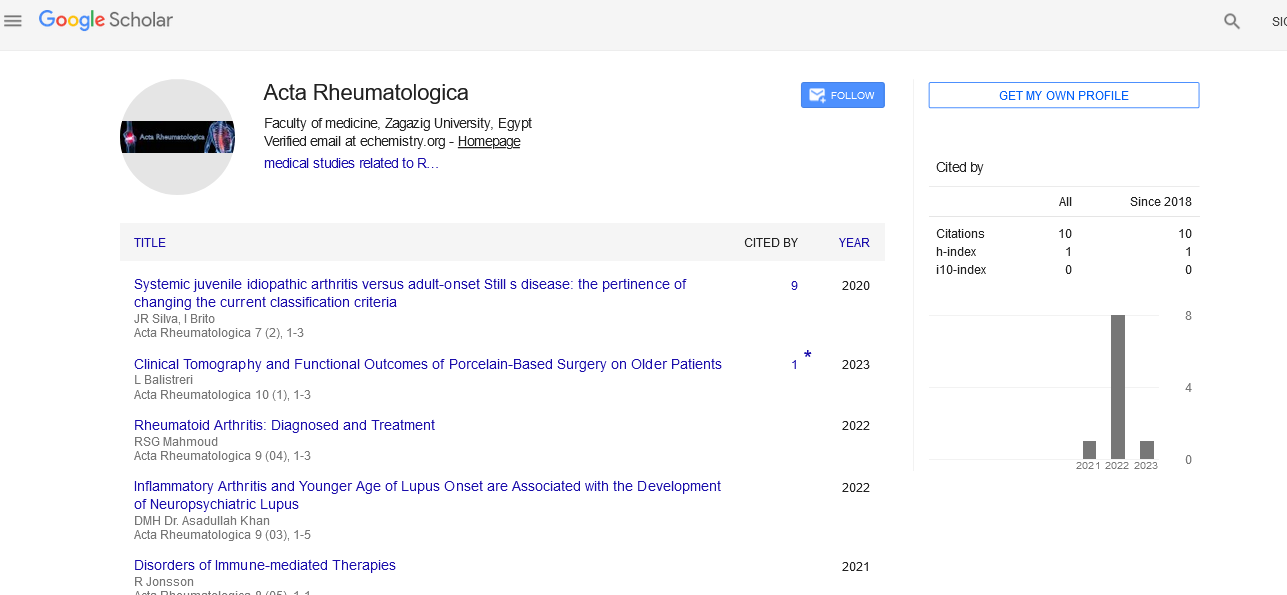Perspective - (2024) Volume 11, Issue 4
Fibromyalgia: Understanding the Enigmatic Pain Syndrome
Qinghua Fang*
Department of Science, Kansas City University, Missouri, USA
*Correspondence:
Qinghua Fang, Department of Science, Kansas City University, Missouri,
USA,
Email:
Received: 14-Jul-2024, Manuscript No. IPAR-24-15057;
Editor assigned: 17-Jul-2024, Pre QC No. IPAR-24-15057 (PQ);
Reviewed: 31-Jul-2024, QC No. IPAR-24-15057;
Revised: 09-Aug-2024, Manuscript No. IPAR-24-15057 (R);
Published:
19-Aug-2024
Introduction
Fibromyalgia is a complex and often misunderstood chronic
pain condition that affects millions of people worldwide,
predominantly women. Characterized by widespread
musculoskeletal pain, fatigue, sleep disturbances, and cognitive
difficulties, fibromyalgia can significantly impact daily functioning
and quality of life. This article delves into the intricate details of
fibromyalgia, exploring its symptoms, causes, diagnosis, treatment
options, and the evolving perspectives on managing this
challenging syndrome.
Description
Understanding fibromyalgia
Fibromyalgia is a chronic pain syndrome characterized by
widespread musculoskeletal pain and tenderness, often
accompanied by other symptoms such as fatigue, sleep
disturbances, cognitive difficulties (often referred to as "fibro
fog"), and mood disorders. It is considered a central sensitivity
syndrome, where the nervous system amplifies pain signals,
leading to heightened pain perception throughout the body.
Causes and risk factors
The exact cause of fibromyalgia is not fully understood, but
research suggests it involves a combination of genetic,
environmental, and psychological factors. Some potential triggers
and risk factors include:
Genetics: Family history of fibromyalgia or related conditions.
Physical or emotional trauma: Such as injuries, infections, or
psychological stressors.
Abnormal pain processing: Dysregulation of neurotransmitters
in the brain that amplify pain signals.
Sleep disorders: Poor sleep patterns or disorders like sleep
apnea may contribute to symptom exacerbation.
Women are more commonly affected by fibromyalgia than
men, and it can occur at any age, though it is most often
diagnosed during middle adulthood.
Symptoms of fibromyalgia
Fibromyalgia is characterized by a constellation of symptoms
that may vary in intensity and fluctuate over time. Common
symptoms include:
Widespread pain: Pain that affects both sides of the body,
above and below the waist, and along the spine. The pain may
be described as deep, dull, aching, or burning.
Fatigue: Persistent tiredness and lack of energy, even after
adequate rest.
Sleep disturbances: Difficulty falling asleep, waking frequently
during the night, or non-restorative sleep.
Cognitive difficulties: Memory problems, difficulty
concentrating, and impaired cognitive function (fibro fog).
Other symptoms: Headaches, Irritable Bowel Syndrome (IBS),
Temporomandibular Joint Disorders (TMJ), sensitivity to noise,
light, or temperature changes, and mood disorders such as
anxiety or depression.
The overlap of symptoms with other conditions and the
subjective nature of pain can contribute to diagnostic challenges.
Diagnosis
Diagnosing fibromyalgia involves a thorough clinical
evaluation and ruling out other conditions that may mimic its
symptoms. Key aspects of diagnosis include:
Medical history: Detailed discussion of symptoms, their
onset, duration, and impact on daily life.
Physical examination: Identifying tender points (specific areas
of tenderness in muscles and soft tissues).
Diagnostic criteria: The American College of Rheumatology
criteria, which include widespread pain lasting at least three
months and the presence of tender points, although newer
guidelines emphasize symptom assessment over tender points.
Laboratory tests: Blood tests to rule out other conditions such
as autoimmune diseases, thyroid disorders, or vitamin
deficiencies.
Since fibromyalgia does not have specific diagnostic tests, a
multidisciplinary approach involving rheumatologists, pain
specialists, and other healthcare providers is often needed to
confirm the diagnosis.
Treatment options
Managing fibromyalgia involves a multimodal approach
tailored to individual symptoms and needs. Treatment strategies
may include:
Medications: Pain relievers such as acetaminophen or NSAIDs for
mild pain, antidepressants (such as duloxetine or amitriptyline) to
improve sleep and mood, and anti-seizure medications (like
pregabalin or gabapentin) to reduce nerve pain.
Cognitive Behavioral Therapy (CBT): Helps individuals develop
coping strategies, manage stress, and improve sleep hygiene.
Physical therapy: Exercises to improve strength, flexibility,
and reduce pain, as well as techniques such as massage or
acupuncture.
Lifestyle modifications: Establishing a regular sleep schedule,
practicing relaxation techniques (such as yoga or meditation),
pacing activities to avoid overexertion, and maintaining a
balanced diet to support overall health.
Individualized treatment plans may combine several
approaches to address the complex nature of fibromyalgia and
improve quality of life.
Living with fibromyalgia
Coping with fibromyalgia requires a proactive approach to
managing symptoms and optimizing well-being:
Self-management: Educating oneself about fibromyalgia,
identifying triggers, and implementing strategies to manage pain
and fatigue.
Support network: Seeking support from family, friends, support
groups, or counseling to cope with emotional and psychological
aspects of the condition.
Healthy habits: Engaging in regular physical activity within
personal limits, maintaining a balanced diet, getting adequate
sleep, and managing stress effectively.
Advocacy and education: Raising awareness about
fibromyalgia, promoting research, and advocating for improved
healthcare resources and support for individuals living with the
condition.
Research and future directions
Research into fibromyalgia continues to evolve, focusing on
understanding its underlying mechanisms, identifying biomarkers
for diagnosis and monitoring, developing targeted therapies, and
exploring non-pharmacological interventions. Clinical trials and
collaborative efforts are crucial in advancing knowledge and
improving treatment outcomes for individuals with fibromyalgia.
Conclusion
Fibromyalgia is a multifaceted chronic pain syndrome that
affects millions worldwide, impacting physical, emotional, and
social aspects of life. Through comprehensive management
approaches, education, and ongoing research, there is hope for
improved understanding, diagnosis, and treatment of
fibromyalgia. By fostering supportive communities and advocating
for enhanced care, we can empower individuals with fibromyalgia
to better manage their symptoms and lead fulfilling lives despite
the challenges posed by this complex condition.
Citation: Fang Q (2024) Fibromyalgia: Understanding the Enigmatic Pain Syndrome. Acta Rheuma Vol:11 No:4





